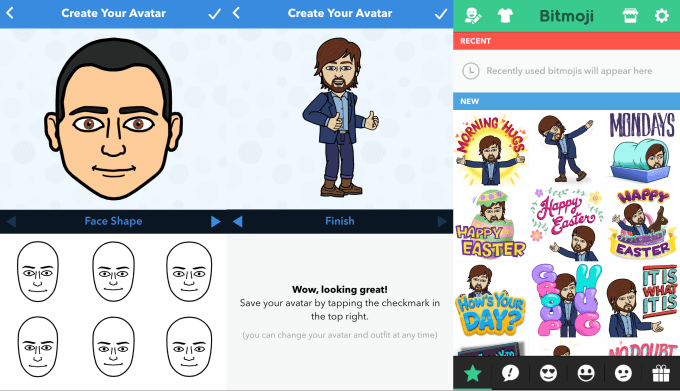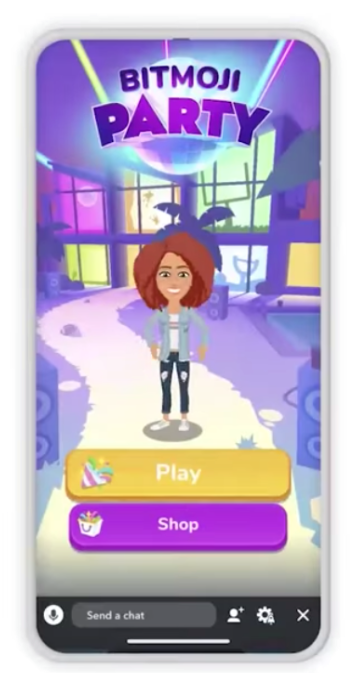Want your video game character to look just like you? Soon you’ll be able to scan an in-game code with Snapchat to play as your personalized Bitmoji avatar on PC, console, and mobile games. Today Snapchat announced is new Bitmoji For Games SDK that will let hand-selected partners integrate 3D Bitmoji as a replacement for their character skins. With support for Unity, Unreal, and the Play Canvas engine behind Snap’s new Bitmoji Party game inside Snapchat, the SDK should make it easy for developers to pipe in life-like avatars that give people a stronger emotional connection to the game.
“It’s kind of a no-brainer to bring Bitmoji into games. Games can be so much more engaging with you…in the game” Bitmoji co-founder Ba Blackstock tells me. “We’re adding an identity layer to gaming that has the potential to have a transformational effect on the industry.”
Snapchat has a massive opportunity to colonize the web — and the games ecosystem — with its Bitmoji instead of waiting for developers to make half-assed clones. Bitmoji is perhaps Snapchat’s most popular and enduring feature now that Stories and ephemeral messaging have been widely copied. As I wrote in my feature piece on Snapchat’s new platform strategy, “To stop copycats, Snapchat shares itself”, every distributed instance of the company drives attention back to its original apps, and each partnership it establishes is one more ally in the fight against Facebook.

As Snapchat moves into this new era of marketing itself through Bitmoji, today it also announced it’s hired a new CMO, Kenny Mitchell. He was formerly the VP of marketing at McDonald’s and the head of consumer engagement at Gatorade. Mitchell oversaw the sports drink’s Serena Wlliams tennis game that lived inside a Snapchat ad and saw an average of over 200 seconds of play time, and its viral Super Bowl augmented reality lens that let you dump a cooler of Gatorade on yourself.
“Kenny’s consumer marketing expertise and his deep understanding of our products will be a great combination for Snap” writes Snap CEO Evan Spiegel. The company has seen many senior execs depart over the years due to clashes with Spiegel over leadership, so we’ll see if Mitchel sticks around. He’ll be spearheading Snap’s new marketing campaign to reactivate Android users frustrated by its buggy app and bring them back to its newly reengineered version. “I look forward to helping Evan and Snap continue to tell their story to people around the world, and working with my new colleagues as we define the future of the camera and self-expression” Mitchell writes.
Bitmoji, The Visual Identity Layer
Snap acquired Bitmoji parent Bitstrips in 2016 for just $64 million, propelling it to become a staple top 10 app. Snap launched its Snap Kit platform in June 2018, allowing developers to integrate Bitmoji into the keyboards of their apps like Tinder for use as chat stickers or 2D profile pics. And this month at Snap’s first Partner Summit, it launched partnerships to bring Bitmoji to the Venmo feed, Fitbit watch faces, and more. But now it will let 3D Bitmoji replace your in-game character head-to-toe.
 For now, the SDK will be free to top developers chosen for the program from PC, Mac, Xbox, Playstation, Nintendo Switch, iOS, Android and other platforms. Surprisingly, most game devs just build their own avatar customization feature from scratch, but it’s typically focused on clothes and crazy hairstyles than fine-tuning a face that looks like your own.
For now, the SDK will be free to top developers chosen for the program from PC, Mac, Xbox, Playstation, Nintendo Switch, iOS, Android and other platforms. Surprisingly, most game devs just build their own avatar customization feature from scratch, but it’s typically focused on clothes and crazy hairstyles than fine-tuning a face that looks like your own.
Bitmoji For games won’t be an open platform to ensure the brand isn’t misused. Blackstock explains that “You can look at what we’re doing with Bitmoji Kit where we have guidelines of best practices of how to use Bitmoji and not use Bitmoji. We’ll apply the same kinds of guidelines to gaming.” That might mean no extra graphically violent games, or anything in which players might revel in inflicting pain on a personalized avatar. But Fortnite, with its cartoony violence might be an ideal Bitmoji partner.
Snap’s global head of gaming partnerships John Imah says he could imagine using his Bitmoji in titles from Star Wars, Lego, Mario Kart, or Warcraft. Depending on how their models for characters, landscapes, and items work, developers may have to do some work to make BItmoji work gracefully. But Imah says when it can “There will be some modification on our end to make sure this works within their engine so we can make this process as seamless as possible for these developers.”
Users will design their avatar in the Bitmoji or Snapchat app, though there may be in-game customization options down the line. If users ask to import their Bitmoji, the game will show a QR Snapcode on screen that users can scan with the Snapchat camera. That authentication unlocks their Bitmoji to use as an avatar skin in the game. Suddenly, every quest, battle, and cutscene becomes about them, not some generic character.
Given Fortnite is earning hundreds of millions of dollars selling cosmetic upgrades, the inevitable question is whether Snap will start selling bonus outfits, items, or face options for Bitmoji. “It’s really early days for Bitmoji For Games. It’s something we’ll explore later down the road” Imah tells me. That could be a lucrative new business for Snap that’s strengthened by each Bitmoji partnership, and at a time when it’s eager to boost revenue and cut losses as it aims for profitability.
Bitmoji For Games could cement Snapchat as the best way to visually represent yourself online without a photograph. As the darker sides of the Internet and human nature come into focus for the tech industry, we need more ways to both be ourselves while retaining privacy. Bitmoji could deliver the emotional connection of seeing yourself as the hero without the risks of exposing your true face.
from Social – TechCrunch https://tcrn.ch/2W1LlX2
No comments:
Post a Comment